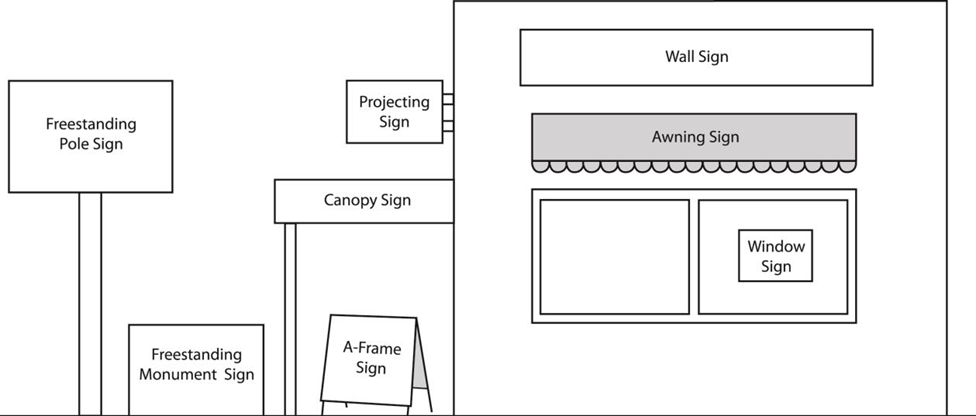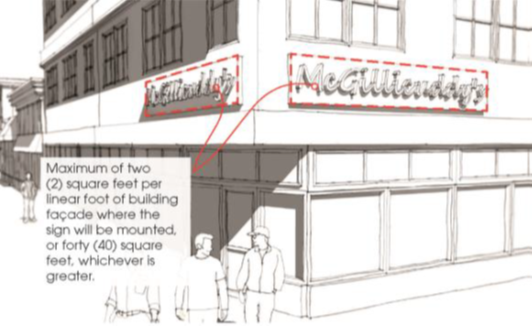Examples of common signs:

(A) A-frame signs. A-frame signs are permitted as indicated in § 153.101(B)(2), subject to the following regulations.
(1) A-frame signs are limited to 6 square feet in area per side and 4 feet in height. The use of A-frame signs is limited to business hours only and may only be displayed during daylight hours. Signs must be stored indoors at all other times.
(2) An A-frame sign must be placed on the property where the business is located and within 10 feet of the primary entrance of the business or out of the right-of-way in front of the property. A-frame signs must provide an unobstructed sidewalk width of at least 5 feet for pedestrian passage and must not interfere with pedestrian traffic or violate standards of accessibility.
(3) The permit applicant must provide and maintain in force a certificate of insurance, in a form approved by the city, that evidences that the applicant has in force insurance in the minimum amounts required by the city for bodily injuries or property damage in any 1 year protecting such person or organization and the city against liability for injuries or damages resulting from the placement of such objects or materials in the public right-of-way. Proof of insurance must be renewed on an annual basis.
(4) A-frame signs are permitted in the commercially zoned districts only.
(5) Only 1 A-frame sign is permitted per business.
(6) The sign shall be professionally painted and maintained in a neat and readable manner.
(7) Signs shall not be staked into the ground.
(8) Signs shall not be lighted and shall not utilize noise amplifiers.
(9) Properties which have a changeable message sign may not display an A-frame sign.
(10) Signs may be displayed only during hours of operation.
(B) Awning signs. Awnings without printing, with the exception of a street address number (number only), are considered an architectural feature and are not regulated by this section. Awning signs are permitted as indicated in § 153.101(B)(2), subject to the following regulations.
(1) Awning signs must maintain a minimum vertical clearance of 7 feet 6 inches.
(2) Awning signs must be located a minimum of 18 inches from the back of curb.
(3) Awning signs must comply with Minnesota State Building and Fire Codes, including provisions for encroachment into the public right-of-way, structural requirements, sprinkler protections, and similar regulations.
(4) Awning signs must be made of a durable, weather-resistant material like canvas, canvas-like material, nylon, vinyl-coated fabric, or metal. Solid, flat-roofed awnings may also be made out of finished wood, wood and plastic composites, metal, or metal cladding.
(5) Printing on any awning sign is limited to 30% of the surface area.
(6) Awning signs are permitted lettering attached to and located above the top of a solid awning to a maximum height of 24 inches. Signs mounted to solid, flat roofed awnings are limited to individually-mounted letters with internal illumination (if illuminated), or a sign board with external illumination; no internally illuminated cabinet signs.
(7) Awning signs may illuminate the printed area of the awning with gooseneck or similar external illumination. Back lit awnings are prohibited.
(8) Under-awning signs are permitted subject to the following.
(a) Under-awning signs must be attached to the underside of an awning. Under-awning signs may not project beyond the awning.
(b) Under-awning signs must maintain a minimum vertical clearance of 7 feet.
(c) A maximum of 1 under-awning sign is permitted per business establishment with frontage on the street where the awning is mounted.
(d) Each under awning sign is limited to a maximum of 6 square feet.
(e) Under-awning signs must be securely fixed to the awning with metal supports.
(f) Under-awning signs must be made of wood, metal, or plastic.
(9) A sign permit is required for recovering or resurfacing an existing awning sign.
(C) Canopy signs. Canopies without printing, with the exception of a street address number (number only), are considered an architectural feature and are not regulated by this section. Canopy signs are permitted as indicated in § 153.101(B)(2), subject to the following regulations.
(1) Canopy signs must maintain a minimum vertical clearance of 7 feet 6 inches.
(2) Canopy signs must be located at least 18 inches from the back of curb. Support posts must maintain a minimum separation of 5 feet between posts and between the posts and any building wall. No obstructions are permitted within this area.
(3) Canopy signs must comply with Minnesota State Building and Fire Codes, including provisions for encroachment into the public right-of-way, structural requirements, sprinkler protections, and similar regulations.
(4) Canopy signs must be made of a durable, weather-resistant material like canvas, canvas-like material, nylon, vinyl-coated fabric, or metal. Solid, flat-roofed canopies may also be made out of finished wood, wood and plastic composites, metal, or metal cladding.
(5) Printing on any canopy sign is limited to 30% of the surface area. Signs mounted to solid, flat-roofed canopies are limited to individually-mounted letters with internal illumination (if illuminated) or a sign board with external illumination; no internally illuminated cabinet signs.
(6) Canopies may include underside, external illumination.
(7) Under-canopy signs are permitted subject to the following.
(a) Under-canopy signs must be attached to the underside of a canopy. Under-canopy signs must not project beyond the canopy.
(b) Under-canopy signs must maintain a minimum vertical clearance of 7 feet.
(c) A maximum of 1 under-canopy sign is permitted.
(d) Each under-canopy sign is limited to a maximum of 6 square feet.
(e) Under-canopy signs must be securely fixed to the canopy with metal supports.
(f) Under-canopy signs must be made of wood, metal, or plastic.
(D) Changeable message signs. Changeable message signs are permitted as indicated in § 153.101(B)(2), subject to the following regulations.
(1) Only 1 changeable message sign per lot is permitted.
(2) Each message or image displayed on a changeable message sign must be static or depicted for a minimum of 8 seconds.
(3) Changeable message signs are permitted as part of a freestanding sign, wall sign, or marquee, and, in addition, are subject to the requirements for those sign types.
(4) Changeable message signs must be integrated into the larger sign structure and must include the name of the use as a non-electronic component as part of the sign structure. Changeable message signs are limited to a maximum of 60% of the sign area of the freestanding or wall sign with which it is integrated.
(5) Changeable message signs cannot display any off-premises commercial advertising.
(6) The sign shall be at least 50 feet from any residential district or use; the following modes of displaying the message shall be permitted, all other modes are prohibited:
(a) Fade in and fade out;
(b) Left to right or right to left; and
(c) Top to bottom or bottom to top.
(7) Modes which cause the message to flash are prohibited.
(8) Brightness. The brightness of the sign may not at any time exceed 0.3 foot candles above ambient light levels as measured from 50 feet from the sign's face. The sign must be equipped with automatic dimming technology or other mechanism that automatically adjusts the sign's illumination level based on ambient light conditions.
(9) The sign must be able to automatically go on and off at certain times.
(10) Display. The text and images displayed must be complete in themselves, without continuation in content to the next image or text or to any other signs.
(11) Acknowledgment. Prior to the issuance of a sign permit for a sign, each property owner must sign an acknowledgement indicating agreement to comply with these standards.
(12) Enforcement. All outstanding code compliance issues must be resolved before a permit for a changeable message sign may be approved. Upon installation of a freestanding changeable message display sign, the property owner acknowledges that the property may no longer display any temporary banners, or A-frame signs. All window signs must comply with this subchapter, both permanent and temporary. The person owning or controlling the sign must adjust the sign to meet the standards of this code or turn the sign off within 1 business day of notice of noncompliance by the city. Once the issue has been corrected, the owner/operator shall notify the city prior to turning the sign back on.
(E) Monument signs.
(1) Landscaping consisting of mulched shrub and perennial bed shall be installed around the base of the sign, with a landscaping plan to be approved by city staff.
(2) In R-3A and R-3B, 1 monument sign is permitted per property or development, whichever is more restrictive, in residential districts for residential subdivisions and multi-family dwellings of 9 or more units. The sign shall be designed to be architecturally compatible with the building or project, and shall be landscaped around the base of the sign. Monument signs in residential zoning districts may be lit internally provided that portions of the sign not devoted to changeable messaging consist of white or light-colored lettering with a dark, un-lit background. All internally illuminated signs shall be light-colored lettering with dark, unlit background.
(F) Wall signs. Wall signs are permitted as indicated in § 153.101(B)(2), subject to the following regulations.
(1) Wall signs may be internally or externally illuminated. If externally illuminated, all light must be directed onto the sign face from above.
(2) Wall signs must be safely and securely attached to the building wall. Wall signs must be affixed flat against the wall.
(3) No wall sign mounted on a structure may project above the roof of the structure to which it is attached, including the sign support structure.
(4) Wall signs must be constructed of wood, brick, metal, or plastic. Wall signs of durable, weather-resistant material like canvas, canvas-like material, nylon, or vinyl-coated fabric are also permitted but the signs must be held taught to the building with no sags or wrinkles and the mounting devices must be concealed by a frame that covers the entire perimeter of the banner.
(5) Wall signs must not cover windows, doors. or architectural features.

(6) Commercial buildings. For single tenant buildings, wall signs are permitted on the front, side, or rear of a building, except that wall signs may not face abutting residential property on the side or rear of a building.
(Ord. 2018-10-3, passed 10-9-2018; Am. Ord. 2019-8-3, passed 8-13-2019)